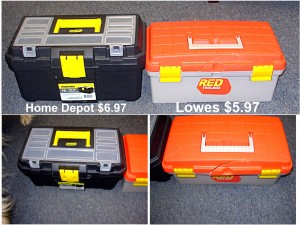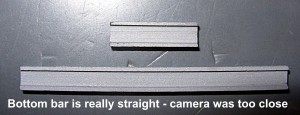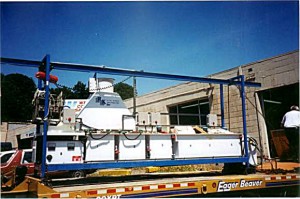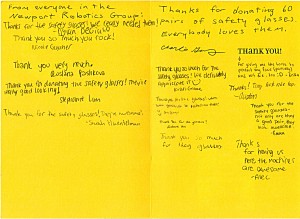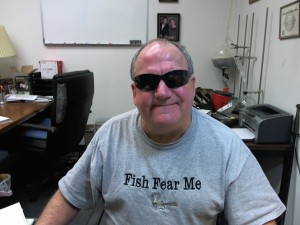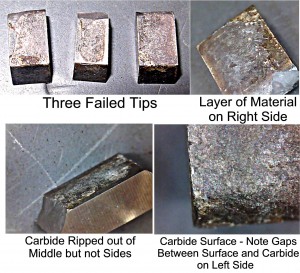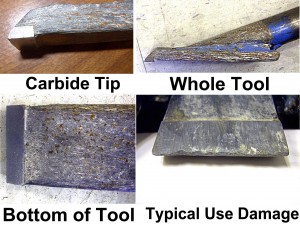Welcome to the Carbide Processors Blog
Kid’s Tool Boxes – The Box
Posted on Tuesday, November 29th, 2011 at 7:32 pm.
Tool Box Comparison
The grandkids are growing up and they like using tools. Howard wants a “hammering log” for Christmas. He wants a big piece of wood where he can drive nails.
I went on line looking for kid’s tool kits. All I found were from Lowes so I bought all five varieties. They duplicated one set and shorted me on another one.
Here are my reviews of kid’s tool kits.
Kid’s Tool Boxes
I bought the Lowes online for $5.97. This is the box with the orange top. I tried to stand on it and it broke as soon as I put any weight on it. So I went to Home Depot and spent $6.97 on a bigger tool box that I could stand on without breaking it.
Lowes RTB PLASTIC TOOLBOX
Item#:128453 / Model#:TB0011 / $ 5.97
Pretty flimsy box. Plastic is just too thin. Another $0.50 worth of plastic would have really helped. Buy a real tool box somewhere.
Home Depot
731161025693 HMR16TOOLBX <A> $6.97 Tool box
Real tool box that a 240# man can stand on.
How to Buy Custom Carbide Parts
Posted on Friday, November 18th, 2011 at 10:11 pm.
Prototype Parts Can Be an Excellent Investment
We sell a great number of custom carbide parts. Some of them are made directly off of drawings. Another way to do it is to buy a few sample parts first.
If it is your first time buying custom carbide parts then getting a couple of sample parts can be a really good idea.
It adds maybe a couple hundred dollars and 4 to 6 weeks to the process. However, that is far and away preferable to opening up a box of parts made from a drawing and finding out that they read the drawing differently than you did. You can take that advice as coming from somebody has made that mistake more than once.
Tungsten carbide shrinks about 40% during the sintering process. The amount it shrinks is never an exact process. The tungsten carbide parts start with pressed powder. They can twist or warp or bow or otherwise move during the sintering process.
A good carbide company will be very hesitant to promise results within more than a couple thousandths of an inch although they usually do better than that.
We really believe that spending a little extra money and a little extra time to get actual physical parts can often be a great investment. You will get actual parts that you can run to your parts feeder, mate with other parts, use to build prototypes and uses reference points if you want any changes made to your production parts.
We work with a couple of companies that are really excellent at making prototype parts and would be happy to help you.
We Sell Carbide
800 346-8274
How to Braze Tungsten Carbide – Surface Preparation
Posted on Friday, November 18th, 2011 at 9:18 pm.
Treating Tungsten Carbide for Brazing
In order to get a good braze joint the braze alloy has to stick to both the tungsten carbide and the steel. With steel it is usually just a matter of having a clean surface that is absolutely free of greases and oils. Getting a piece of tungsten carbide to wet and braze well can be a much more difficult matter.
Tungsten carbide is made of tungsten powder, carbon powder (lamp black) and cobalt powder. This is the traditional formula. Modern carbide grades will have additives such as chrome to make the binder more corrosion resistant, grain growth inhibitors to make finer grains and other materials to make the carbide tougher or longer wearing.
My theory is that the number one cause of wetting problems with tungsten carbide is the presence of carbon on the surface of the tungsten carbide. Traditionally tungsten carbide has been sandblasted after sintering. This is to clean it up and remove any sand if it was sintered in sand trays, for example. I believe the sandblasting can remove some carbon and some oxides but I don’t think it does a good enough job all the time. Sandblasting can remove rust, paint and similar from an underlying surface. However it cannot remove greases and oils entirely. What happens is that the sand in the sandblasting picks up much of the greases and oils. However there is also a smearing effect by which the sand in the sandblasting operation distributes the oil and grease in an even layer over the part. There is also a tendency to drive the oil and grease into the underlying material as much as possible.
I have been working on making carbide wettable since 1981. What follows is my opinion on how I see the situation. In 30 years we have treated umpteen million pieces of carbide to improve the wetting and bonding properties.
The first experiment was to take a piece of carbide that would not wet. We then ground the surface with an ordinary wheel from a Sears bench grinder. We ground the surface a couple of times cleaning the wheel in between. Once we had ground the surface we had a piece of carbide that wet readily.
For number of reasons, physical grinding was not a suitable process for us to use in production. In that operation we were tinning (or pretinning) tungsten carbide saw tips for a couple cents each. There was no way we could afford to grind each saw tip and there was really no way we could practically grind a hundred thousand saw tips a day.
So I went looking for a chemical process. Don Anderson, who was head of cutting tool research and development at Weyerhaeuser, gave me a pamphlet on removing scale from steel. The steel process used a mixture of potassium permanganate and sodium hydroxide. They made a big bath and just ran the steel through it. When I tried this with carbide the improvement was marginal at best.
What I ended up doing was drastically changing the ratios of the two chemicals and altering the way the process was used. We now put the carbide in the treating vessel and dump dry powder on top of it. We then add enough water to make a sludge and heated it at a gentle boil for about 20 min. This leaves the tips with a dark brown coating which does not seem to interfere with the brazing. These tips will re-oxidize if the brazing cycle is too long or too slow.
What I think happens is that the KMnO4 (Potassium Permanganate) breaks down and does two things. I think it removes free carbon from the surface of the tungsten carbide. I also think it helps remove oxides. The sodium hydroxide obviously does a good job on removing all oils and greases. These are assumptions are somewhat confirmed by the fact that the process produces a gas that extinguishes a flame. I mentioned that we initially add enough water to make a sludge. At the start of the process more water is created. By the end of the 20 min. we may have lost water due to evaporation from the boiling.
I believe it is in this initial reaction involving the free carbon on the tungsten carbide with the potassium permanganate and sodium hydroxide that actually prepares the surface to make it much more wettable.
We have run that process for about 25 years now. It is relatively inexpensive, pretty safe, pretty easy and we have permission to dispose of the spent chemicals in the city sewer.
There is a commercial treatment process currently in operation. It is a patented process and I will be happy to provide a copy of the patent for anyone who cares to look at it. In essence the patent calls for treating the tungsten carbide parts in a 2200° salt bath followed by a quench in us in a hot, cyanide salt bath.
This has been described as causing the cobalt binder to migrate to the surface. It has also been described as removing the tungsten carbide from the surface which leaves the cobalt exposed.
Looking at the drawings on the patent, they looked to me like unwettable carbide which had been cleaned. They show a definite improvement in the wetting but it is not a perfectly wettable surface. In addition the test parts were heated with the tungsten carbide lying on top of the braze alloy.
The cyanide salt bath never made any sense to me. Why would you use a cyanide salt bath for anything unless you absolutely had to?
The original patent indicates that the inventor worked for a twist drill company and I believe that he tried running some tungsten carbide through a plating operation to see what would happen.
I thought that you could take the heat out of the equation and the salt baths. Instead you should be able to plate in aqueous solutions at reasonable temperatures.
The key to any plating operation is an absolutely, scrupulously clean surface.
Sandblasting does not yield a surface clean enough on a reliable basis. With plating, an interference layer of something such as oil or grease can greatly affect results even if it is no more than a molecule thick.
There are two theories to customer support. Plan A, once a customer has bought it, you don’t have any further responsibility. Plan B, you have the obligation to help your customers use your product successfully.
We have always been Plan B people so we got into research on how to prepare the steel for successful brazing in that we had nothing to do with the steel.
Working with the steel preparation made it extremely clear to us just how critically important cleanliness was to successful brazing. You can get steel clean enough with solvents but it is much more common that someone leaves a thin film on the steel. The same is true with wiping with a clean rag.
Cleanliness is absolutely essential to successful brazing and successful plating. This is hardly surprising since both processes are at their best when they create a chemical bond between the two metals.
We developed the cleaning process we had several criteria. Our operation is in the City of Tacoma which is extremely sensitive about environmental issues affecting drinking water. The last glacier that came through scraped off all the cap rock so anything that spills on the ground goes directly into the drinking water. In addition we wanted the standard attributes of low-cost, reliability, safety, etc.
We developed a specific electro-cleaning process. We use a small, tumbling barrel to hold the tungsten carbide parts. We run an electric current from a stainless steel plate to the tungsten carbide parts. (See more detail below.) This cleans the parts. It also generates fine grit in the bath and often generates a film on top of the bath. When we ran the process for an extended amount of time on a production basis we created a film that we believe was a polymer.
We found that by cleaning the parts in this manner and then reversing the current we could prepare the surface of tungsten carbide to wet successfully. We believe that this process separates the tungsten carbide grit from the cobalt matrix because the difference in electrical resistivity is so great. This process either prepares the tungsten carbide parts to wet completely or greatly improved the wettability.
A major issue in all this research was the variation in the parts we received. There is certainly variation among manufacturers but there can also be significant variation among batches from the same manufacturer. In effect, you are running a chemical process where there is the addition of an unknown chemical. That unknown chemical seems to very both in description and in quantity.
Designing a chemical process that is reliable on materials with unknown contaminants calls for an extremely robust, forgiving process.
The commercial treatment company has been dominant in the industry for decades and rightly so. When their process works right it does an excellent job. However their process does not always work right. In addition there seems to be very little flexibility in their throughput so that lead times can often run into months.
There’ve been many attempts over the years to create a successful tungsten carbide treatment process. Most have failed because the processes have not delivered consistently high quality.
Many of these attempts have been plating processes to the extent that plating tungsten carbide has gotten a very bad reputation. We have seen and worked with many of these processes. I believe that, universally, the cause of failure was a process control issue. Specifically I would point to the initial cleanliness of the parts.
However the commercial treatment company delivers parts with a certain look and that look has become the industry standard for reliable quality. A second indicator of quality, as perceived by the industry, is the presence of microscopic holes in the treated tip.
Because our two existing processes left the tips dark there was a hesitancy on the part of industry to except them.
The next step was to develop a successful process that made the tips look right.
As I read the commercial treatment company process in the patent it appeared to me more likely that it was, in effect, a plating process. I cannot imagine anyone, at any time developing a cyanide-based process unless it was absolutely essential to use cyanide. There is mention in the patent of an electrode in the cyanide tank.
We took the electro-cleaning process and added two more steps with rinse steps in between. The second step was an acid bath. It was originally a dilute hydrochloric bath. When I run the process for titanium-based products I had hydrochloric acid to the hydrochloric as it seems to improve effectiveness and reliability.
The third step is a cobalt plating process. It is a pretty standard plating process except for the cobalt. We used cobalt because that is what the industry wants. I think the process could be done equally well with equal or superior results using a nickel plating. In addition the nickel plating process would be much less expensive. Finally, if you found someone who was familiar with nickel plating to run the process, they would find a huge number of ancillary processes and suppliers to support them. It is extremely difficult to find anyone who knows anything about cobalt plating or who can supply materials for the process. We developed our own titration standard for the cobalt bath. This would not have had to be done with a nickel bath. There is also a huge body of literature on the problems with and methods of controlling nickel baths compared to little or nothing about cobalt baths.
As I write this, on November 18, 2011, this is where we stand. I had originally hoped to run the process here that the city of Tacoma will not allow it. I had hoped to license the process but no one really seems to be interested in licensing a process that is not running. I have licensed a couple versions of chemical treatment processes. There is a problem with this. As one gentleman told me, the process didn’t work the first couple times he tried. Then he followed my directions and it worked. This is much like giving a recipe to a friend. They make substitutions and then are unhappy with you because they don’t get the results you did.
The commercial treatment company seems to be having problems with their treatment process lately. My lead time for parts is extended several weeks if not a couple months. Some of the parts we are receiving do not wet well and we have to retreat them here. Some of the parts work extremely well but don’t seem to adhere very well when brazed.
I am posting this information in the hope that it will aid someone working on the same problem. I would really like to see the carbide manufacturers ship ready to braze parts directly from their plants.
Tuffco Process — Lab Instructions
Three Tanks from left to right
NaOH – 150 F Use 20 – 22 Amps – No More than 25 amps at 6 – 10 volts for 5– 6 minutes
Rinse Hot Water 2 minutes
HCl – 80 F for 5 minutes with no electricity
Rinse Cold Water 2 minutes
Cobalt – 100 F at 6 – 7 amps for 15 min. for small barrel 40% full
Rinse Cold Water 2 minutes
Preparing the Baths – Tuffco Process
Deionized water is best for solutions. Tap water usually works well enough for rinsing.
1. Sodium hydroxide (NaOH) 150 g / 1,000 ml Temperature 150° -160° F
A. pH cold 14 and pH hot 13
Water baths
Put 1 Liter of water in the outside bath
Put 1.2 Liters of water in the inside bath
Solution
Use 4 Liters of water
At 800 grams of NaOH which is 880 ml.
Heat to 150° F
2. Hydrochloric acid (110) – 200 ml / 1,000 ml Temperature – (70° – 80° F) pH room temp 4
Water baths
Put 1 Liter of water in the bath
Solution
Use 2 Liters of water
Add 900 ml of HCI
Add 100 ml of HF
Heat to 70 – 80° F
3. Cobalt Solution:
A. Metal concentration off test strip; 1,000 – strip is dark blue – maxed out; pH cold 6.1, pH hot 5.4 – 5.6
Water baths
Put 800 ml of water in the bath
Solution
Use 3 Liters of water
Add 360 g of Cobalt Sulfate which is 400 ml. (Cobalt sulfate COSO4 is 120 g / 1,000 mi.)
Add 240 g of Ammonium Sulfate which is 225 ml. (Ammonium sulfate (NI14)2SO4 is 80 g / 1,000 ml.) Heat to 100° F
* * Check pH every day or more often depending on use
If pH lower than 5.4 add 3% solution of Sodium Hydroxide (3 g / 100 ml) if pH higher than 5.6 then carefully add concentrated sulfuric acid H2SO4
Making the cobalt bath solution
120 grams per liter of cobalt sulfate and 80 grams per liter of ammonium sulfate
Use distilled water and warm the water to 120 F – 130 F to aid dissolution. Do not mix these all at the same time Dissolve Cobalt sulfate first so you can make sure it gets all dissolved. When the cobalt sulfate is totally dissolved then add ammonium sulfate Use the same temperature of 120 – 130 F
As solution cools it will precipitate out and cake on the bottom. When you re-use Cobalt the solution make sure it is fully dissolved. Check the pH should be 5.4- 5.6 when warm
Titrating Cobalt solution
Preparing the cobalt solution for titration
Take 1,000 ml of distilled water and put it in an Erlenmeyer flask. Add 25 ml of the warm, well stirred and fully dissolved cobalt solution.
Stir or shake to fully mix
Take 100 ml of distilled water and add 10 ml of the previous solution (add 10 ml of the stirred solution made by mixing 1,000 ml distilled water with 25 ml of cobalt solution)
Slowly add Ammonium Hydroxide to the beaker until the solution turns yellow, yellow-orange / orange
As soon as it turns yellow – stop
Use Murixide Mix indicator
Add 3/4 of 1/8 of a teaspoon to the solution. The solution will turn from yellow to red
Titration tube
Use EDTA solution and fill the tube to the 25 ml mark
Titrate until you see a blue color
Tittrate very slowly
Multiply amount used by a factor off a chart
13 – 14 ml EDTA will cause a color change in good solution
Over 14 ml EDTA used add distilled water
Under 13 ml EDTA used add cobalt sulfate
We sell Carbide, do Brazing and Pretinning
800 346-8274
Edge Eyewear Donation
Posted on Thursday, November 17th, 2011 at 7:39 pm.
Working with Kids Is Really RewardingWe get asked to contribute to a great number of charities. Unfortunately we can’t fund them all. What is even worse is that a great number of them are really not worth funding.
There are two charities that I particularly like. One is donating baby food or a check for baby food to either the Salvation Army or our local food bank. These are both extremely low overhead operations. A really high percentage of the money donated goes to feed people.
There is a real problem getting baby food for food banks. Baby food has a long expiration life. There really is very little markup on baby food because new mothers shop like crazy. I found this out years ago when I was doing volunteer work with our local food bank. I decided we would take the money we spent on Christmas cards make a donation to a food bank instead. We decided to make a donation for baby food because it is something the food bank really needs.
The other charity we really like is working with kids groups. This year we had a lot of fun with it. We took on a new line of safety glasses that are extremely safe (they meet military specifications), they are very comfortable and they look really cool. We donated a couple hundred pair to various shop classes and robotics groups. That was fun and something we like doing. What is really cool is getting the thank you notes.
This example came from the Newport Robotics Club. We donated 60 pair of safety glasses and got a card in return. Dollar for dollar we probably came out a little behind but that is sure not the way it feels.
Thanks for the card. We love it.
Tom Walz
We sell really cool, really safe eyewear
800 346-8274
How to Braze – Cold Joints
Posted on Friday, November 11th, 2011 at 7:22 pm.
Cold Braze Joints on Monday Morning
I once had an issue where a customer was having braze failure on saw blades made on Monday mornings.
It started out with a report of a braze failure. I asked them to see if they could identify any common circumstances between the failed saws and the great majority of the saws which were beautifully done.
Some record-keeping show that the problems occurred with saws brazed Monday morning.
This was in the winter.
They were following a common brazing practice and brazing on a large, thick, steel brazing table. They come in sizes but think of a piece of steel that is about a yard across and about a foot thick. They would lay the saw plate on top of the piece of steel. Then they would insert shims under the saw plate to raise it enough to give them the proper side clearance. This left the plate raised above the table and only the tungsten carbide tips were resting on the table.
They turned the heat off in the shop on the weekends and turned it back on Monday morning. The turned the heat on early enough to get the shop up to a working temperature. However this was not nearly long enough to bring that huge chunk of steel up to warm.
So what they were doing was brazing with one side of the saw tips resting on this huge, cold chunk of steel. They were getting beautiful joints, as usual, on the upside. However, so much heat was being sucked out of the downside that the joints were too cold and not strong enough.
Once we had this figured out they developed the practice of using the torch to warm the top of the table and the failures disappeared.
Some brazers make it a practice to always warm the top of the table before brazing and some do not. There are brazers that get excellent results with either practice.
How to Braze – Underbrazing
Posted on Friday, November 11th, 2011 at 7:19 pm.
Underbrazing
There is such a thing as underbrazing. This typically occurs with an extremely talented, experienced, conscientious brazer. I believe that sometimes tip loss is caused by not quite enough heat. I am talking fractions of a second and tens of degrees in a brazing process that usually runs around 1400° to 1500°.
Quite often, in brazing saw blades, there is a huge emphasis on protecting the saw plate from being overheated. There is also an emphasis on speed as there is in any manufacturing operation.
Braze alloy melts over a range. In addition to that, once braze alloy hits the melt point it takes a while to make the phase transformation from a solid to a liquid. If you go to YouTube you can see a Carbide Processors video that shows this.
Phase transformation is the scientific term to describe the energy required to turn a solid into a liquid, for example. If you could take a solid up to the temperature of its melting point and hold it there without putting any more energy into it then it would not melt. Once you have a solid hot enough you need to add more energy, typically as heat, to turn it from a solid into a liquid.
If you think about dropping ice cubes into boiling water you sort of get the idea. There are a lot of mechanisms in place in the “ice cube in boiling water” example but at least it illustrates the fact that the transformation from solid to liquid is not immediate.
When you braze tungsten carbide to steel you are brazing material that is about 90 to 95% ceramic to material that is 99+ percent metal. Tungsten carbide grains are a ceramic. The only metal to carry the heat is in the binder which is usually in the 5 to 10% range. Steel is typically 99% metal with a little bit of carbon. Steel accepts heat much more readily than tungstencarbide does.
When the issue of cadmium in braze alloy first came out there was an opinion that brazers were not good enough to tell the difference between braze alloys. By that time I’d been in the industry 10 years or so and I had a pretty good idea just how good some of these people were. I went to a couple of shops with a stopwatch to measure just how good brazers were. I never found out because the brazers were a lot better than my ability to measure them. Their accuracy and repeatability were just incredible.
So what I think happens with under brazing is that the brazer catches the braze alloy somewhere either in the middle of the melting range, just after the melt point or after the melt point but before the tungsten carbide has achieved full temperature.
The tungsten carbide needs to be as hot as the melt point of the braze alloy to achieve a good bond.
The only definite figure I have ever seen for just how much extra heat to use is a NASA figure that recommends an additional 50°F. However this seems to be a good figure for best practice for industry in general.
In addition tungsten carbide is often treated to make it more brazeable. Although the company that does this process insists it is not a plating process I think there could be some value in regarding it that way. As an example, tungsten carbide is not generally thought of as a ceramic but regarding it that way can help clarify a situation.
In the plating literature it is well-established that you can improve the adhesion quality of the plating by baking it after you are through with the plating.
I believe that this effect can happen to a certain extent in the brazing process of tungsten carbide.
The pictures show a tungsten carbide surface. These pieces of tungsten carbide had a treatment on them to make them braze better. The reason these tips came off the saw is that the surface treatment came off the tungsten carbide taking a wee, tiny layer of tungsten carbide with it. One way the surface treatment process has been described is that it causes cobalt to migrate to the surface. If this is true then it is possible that only the cobalt immediately adjacent to the surface migrates. This could leave a discontinuity or gap in the cobalt structure between the cobalt that got hot enough to migrate and the cobalt further inside the tungsten carbide part that did not get hot enough to migrate. Fully heating the tip through would cause the cobalt to move enough to rejoin.
This theory explains the observed results. That doesn’t mean it’s necessarily true.
What is true is that shops that have had trouble with tip loss have solved their problem by using a slightly longer heating cycle. (This doesn’t always work and it is certainly not the only cause or the only solution.) It is usually described as a second or two longer. Personally I think that 2 seconds is a long time but if that’s what works then it doesn’t matter what I think.
It is also true that a heating cycle after plating can give the surface greater adhesion. Whether that is true in this application or not, I do not know but I suspect it might be.
Everything I said about how good brazers can be is absolutely true. Their ability to assess temperature and braze joint condition accurately over and over again can be truly incredible.
We Sell Braze Alloy and Carbide
800 346-8274
Sgt. Douglass
Posted on Friday, November 11th, 2011 at 6:57 pm.
Renee’s husband made sergeant.
Renee is our Ecommerce Manager and many of you have spoken to her.
Her husband is quite a person as well. He is the company sniper and in charge of communciations’ equipment for his company. Personally he is a solid, square shouldered guy who looks a lot like a soldier ought to look.
Tom (I had nothing to do with any of it. I just like him and am really proud of the people in our military.)
Tile Removal with A Carbide Tipped Tool
Posted on Wednesday, November 9th, 2011 at 11:53 pm.
Tile Removal with an Advanced Carbide Grade
This is a carbide tipped tool for removing floor tile from concrete floors. In the top left picture below you can see the piece of tungsten carbide on the front of the tool. To the right is the whole tool the picture below right shows how badly the edge gets beaten up.
Theoretically the ram pushes the carbide point under the floor tiles and pops or scrapes them off. In reality the ram encounters a great deal of stray metal such as rebar, old fittings and anchors, electrical conduit and others.
Using traditional grades of carbide meant either a short useful life for the tool with a tough grade of carbide or frequent carbide repair due to breakage with a long wearing grade of carbide.
We supplied an advanced grade of carbide and a special braze alloy that extends the life of the tool by about a factor of 3 to 5 over any conventional grade of carbide. This advanced grade of carbide is both extremely tough and very long wearing. In addition the special braze alloy allows for field repair of the tool with an oxyacetylene torch.
This greatly increases uptime for the tile removal machine as well as greatly reducing the necessary inventory of spare parts and all but eliminates the need for outside servicing.
This technology is proprietary to Goddard Industries of Rochester, Washington and was developed with the help of Carbide Processors, Inc. of Tacoma, Washington.
We Sell Carbide and Braze Alloy
800 346-8274
How to get your products sold online
Posted on Wednesday, November 9th, 2011 at 5:17 pm.
Good products and a business like attitude are essential
We are always looking for new products to sell. However they have to be high quality products and they have to have a high-quality organization behind them. The term ‘organization’ here is kind of a funny term because it can mean one person. If it is just one person that one person must be able to organize their suppliers, their manufacturing operation and their shipping and delivery operation.
We used to sell a Jack Rabbit drill and drive set. The inventor thought the world needed a better drill and driver combination. He invented one, refinanced his house to have a minimum order built and then set out to sell them.
We took it up and we were actually doing well selling them. Then one day we called to place an order and he said he didn’t think he would sell us any more. He had some left and he thought if he sold them directly then he could pay off his mortgage and get out of it. Then he added that if he had more retailers like us it would’ve worked out really well. So he finally gets one good retailer and decides to quit.
He required us to buy a lot of accessories when we bought full kits because he had overbought on accessories. This left us with a couple hundred dollars worth of accessories that we can’t sell because we cannot offer the full kits. If we do put the accessories up for sale all we get are people calling asking about the full kits.
On the other hand we have a new product called Super Scraper. This is sold to us by a guy who really does know what he’s doing. He has been doing it for several years. He is actually a customer of ours because he buys our advanced grade of carbide called Super C.
It cost us a couple of thousand dollars up front to introduce a new product. We buy an initial inventory, we write marketing and advertising (It is amazing how many people want us to sell a product and they can’t tell us what makes their product special.), we do promotions and spend a lot of staff time on it.
Part of what we do with brand-new products is give some all away so we have actual testimonials from actual people who got them from us and we know exactly how good they are.
We are always looking for new products and we would be really happy to help you.
However that old saw about ‘the better mousetrap’ is only half true. If you build a better mousetrap the world will not beat a path to your door without marketing and advertising.
president@carbideprocessors.com
800 346-8274
Tungsten Carbide Market Mess
Posted on Wednesday, November 9th, 2011 at 5:06 pm.
The Carbide Industry is in a Huge Mess
Supply is very low, prices are very high, choices in sizes and shapes have been much reduced and delivery is all too often uncertain.
A big part of this is the Chinese. The Chinese own most of the world’s supply of tungsten. They used to sell ore, then they sold refined material and now they sell finished tools. They have also been increasing the price over the years. As the price goes up it makes it harder and harder to keep inventory. This is especially true with slow-moving items.
In the saw tip industry we had a company, called Ceratizit, whose marketing strategy for years was to dominate the industry through low prices, high quality and great service. Because Ceratizit was so aggressive in the saw tip industry other carbide companies focused on areas where there was less competition and more profit. Then the huge increase in raw materials and the long, deep depression in housing caught up with the saw tip market. (We may be in a recession in the overall economy but we are definitely in a depression in the housing market and related construction.)
As prices escalated and the market shrank Ceratizit, along with other carbide suppliers such as Kennametal, consolidated plants. Combining plants is something that no intelligent manager does lightly. They cause a huge disruption both in the organization and in the customer base.
To cope with this we have several times the largest inventory in house we have ever had. We have had to do this because we just can’t count on delivery. We keep certain sizes and grades on the shelf for particular customers. We order well in advance for replenishment to make sure we have them. Now we are finding that a promised 4 to 6 week delivery may be three months. In the meantime we have to go to a more expensive supplier and order from them just to get the parts for our customer. The customer is not happy because the parts are late. We have ordered twice as many parts as we need. We pay more for the parts and we thought we would have to. We sold the parts to the customer at the price we promised. So the whole thing is a lot of work and expense and no one’s happy.
It has gotten so bad that we are using a list of 26 carbide suppliers to try and fill our customers’ demands on time and at a good price. We seem to be doing better than most judging by customer comments and our increase in sales. However the labor commitment is huge so our transaction expense is high.
At the bottom is a link to an article. Anthony DeHart has suggested it. The article talks about things easing in the raw material inside of the industry between 2013 and 2015. However that raw material still has to be refined and manufactured into saw tips, router bits, rods, etc.
There is one final, huge problem in the saw tip industry. There is one company that treats tungsten carbide to improve the brazing qualities. As I write this the company is a couple months out on delivery and seems to be having problems meeting those extended terms. In addition, they seem to be pushing their process and we think we are seeing quality issues. This means we wait a long time for the carbide and then it won’t braze to the tool successfully. This is every bit as big a problem as it sounds like. It is made worse by the fact that some of these are our exclusive grades and there is simply no replacement that delivers the same performance.
We currently sell 126 different grades of carbide on a regular basis. None of them are identical in terms of hardness, toughness and density.
What you can do:
Here are some suggestions from Johan Holm. If you have problems getting what you want when you want it he suggests that you consider the following.
- Accept later delivery
- Different grade of the same product.
- Larger size of the same product.
- Other style.
- Metric size instead of inch size.
Note: Johan Holm was in the saw tip industry for many years and had many hundreds if not thousands of friends. He is now working in the tool industry, is very happy and still loves talking about his family and his dog.
Anthony DeHart recommended this:
We sell carbide
800 346-8274



